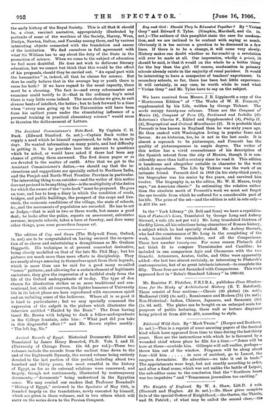The Knights of England. By W. A. Shaw, Litt.D. 2
vols. (Sherratt and Hughes. £2 2s. net.)—Dr. Shaw gives complete lists of the special Orders of Knighthood,—the Garter, the Thistle, and St. Patrick ; of what may be called the second class,—the Bath, Star of India, St. Michael and St. George, the Indian Empire, and The Victorian. These lists are supplemented by one, the Guelphic Order. This, however, is purely Hanoverian, and never implied English knighthood. It was instituted in 1815, and became, of course, wholly foreign when the Crown of Hanover was separated from that of Great Britain. Neither the Thistle nor St. Patrick can be compared, in respect of antiquity, with the Garter. The first was virtually instituted, though nominally revived, in 1687; the second in 1783. The Bath dates from 1725, though there was a similar honour in much earlier times. By the statute of 1725 the Order was to consist of the Sovereign, a Royal Prince, a Great Master, and thirty-five Companions. "And that number," the statute went on, "shall never be augmented." It has, of course, been ;very much augmented. A very numerous class of C.B. has been added, but of Knights proper (G.C.B. and K.C.B.) there are now three hundred and thirty-five, while the Companions number more than a thousand. The second volume is devoted to a catalogue of Knights Bachelor, and also contains an index of the whole. Here, also, the increase in number has been notably large. Roughly speaking, we may estimate the creations between 1754-1804 at three hundred and twenty-eight, between 1804-1854 at eight hundred and sixty, between 1854-1904 at fourteen hundred. We must not omit to say that Dr. Shaw's lists are supplemented by one of " Knights Bachelor dubbed in Ireland," by Mr. G. D. Burtchaell, M.A.











































 Previous page
Previous page